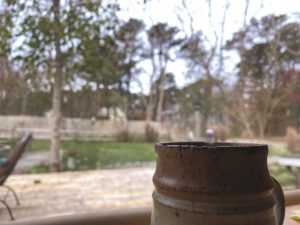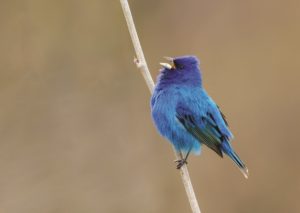Five years ago, I walked out into the yard of the house I was renting and hung a bird feeder. “I like birds,” I thought. “Perhaps I’ll enjoy watching them at the feeder.” At the time, I didn’t know that this simple act would be a turning point in my life. I didn’t realize I was going to turn into a huge nerd and develop a weird, consuming obsession with birds.

There is an elemental joy in watching the birds at the feeders each morning. It is an invitation to be still. To be curious. To notice small things. And yet it makes me feel I am also doing something, an important thing for my productivity-obsessed mind.
I have become that guy at the dinner party who asks the people to either side if they keep bird feeders. My go-to gift for friends is a bird feeder, a bag of black-oil sunflower seed, and a recommendation to download the Merlin app on their phone. I can’t help wanting to share this unexpected realm I’ve found and invite people I care about to find it, too.
There is a ritual to the watching. I wake. The water is set on the stove. As it warms, I go out to the tin bucket of black-and-gray-striped seeds. They smell of a grain and feed store, dusty and earthy, like an old barn. Going out into the cold morning with a scoop of birdseed, standing high up on toes chilled by the morning grass, I experience that first brush with sensation and discipline. The feeders are reached for, taken down, and filled. The seed makes a satisfying clatter as it funnels in and fills the cylinder. Coffee is steeped in the press and poured into the mug with a chipped rim.
Then, I watch, sitting in silence. Nothing sharp. Nothing loud. Just the gentle morning with its rounded edges and soft feathers. This 20-minute interlude is my favorite part of the day. Coffee. Silence. Birds.
They appear from the dense brush of roses and privets, jumping in little bursts from branch to stem. They like cover, finding safety in the snarls of branches and vines. I hang my feeders close to safety now — no longer in the middle of the yard.
They shoot out, little blurs of color and shade, to the feeder. They dive, free-falling from the high branches. A flutter of wings and they gain altitude, level off, and fall again. Their landings on the feeder are controlled crashes, carried out with precision: they reach the feeder and turn upward, wings angled close to their heading to slow their flights, then settle like snowflakes. Tails flip. Delicate claws grip the little posts of the feeders. Sometimes they push one another off. They are playful. I laugh at them. I’ve come to believe that humor is built into the fabric of the universe.

Some mornings, the whole yard comes to life, and I see dozens of birds. The mourning doves, in their smooth, soft grays, pace the ground, propelled by the bobbing of their own heads. Pairs of cardinals fly in, wearing bright red and warm chocolaty browns. There are Northern flickers with black bibs, and gangs of blue jays with wings that rustle in the wind like dry straw. The sparrows rush in, giggling, while the chickadees stand upside down on branches, as if careless to the pull of gravity.
It is not just the leaves that change with the seasons. The birds are a natural calendar, too, marked by the way they move, which species are present, and the colors they wear. Goldfinches are a drab olive green in the winter. Only when the daffodils bloom gold and yellow do they flush into their royal brights. Even the time of day is measured in their movement. Some birds prefer only the slightest of morning light, while others move freely in full sun.
One morning in late summer, my feeder was visited by an indigo bunting. I was walking by the window and some impossibly bright thing stole all my attention. If I had been carrying something, I would have dropped it. A glowing purple gem, nearly spherical, its head nestled tight down into its shoulders. Her feathers scatter indigo light into the world. She was one of the most beautiful things I’ve ever seen.



